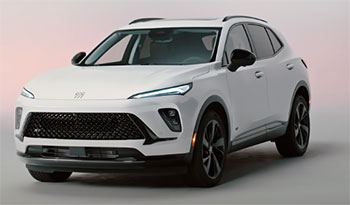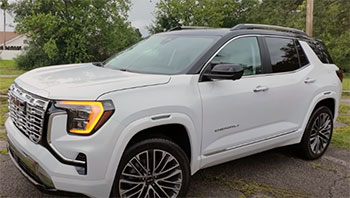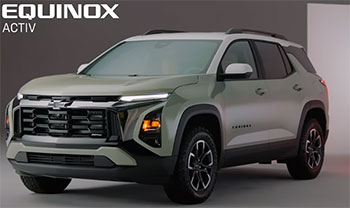I’ve always been fascinated by the compact SUV market—those versatile, family-friendly vehicles that balance style, practicality, and performance. When it came time to compare the 2025 Buick Envision, GMC Terrain, and Chevrolet Equinox, I wanted to understand what sets these General Motors siblings apart.
My goal in this article is to guide you through their key features, weigh their pros and cons, and help you decide which SUV fits your lifestyle. From performance to interior comfort, I’ll share my insights to make your decision easier.
Comparison Table: Buick Envision vs. GMC Terrain vs. Chevrolet Equinox (2025 Models)
| Feature | Buick Envision | GMC Terrain | Chevrolet Equinox |
|---|---|---|---|
| Starting MSRP | $37,895 | $31,395 | $33,599 |
| Engine | 2.0L Turbo I4 (228 HP, 258 lb-ft) | 1.5L Turbo I4 (175 HP, 203 lb-ft) | 1.5L Turbo I4 (175 HP, 203 lb-ft) |
| Transmission | 9-speed automatic | 9-speed automatic | 6-speed automatic |
| Fuel Economy (City/Hwy) | 22/28 MPG | 26/28 MPG | 24/29 MPG |
| Drivetrain | Standard AWD | Standard FWD, AWD available | FWD or AWD available |
| Cargo Space (Max) | 52.7 cu.ft. | 63.3 cu.ft. | 63.9 cu.ft. |
| Passenger Volume | 100.4 cu.ft. | Not specified (similar to Equinox) | 103.5 cu.ft. |
| Infotainment Screen | 30-inch ultrawide | 15-inch touchscreen | 11-inch touchscreen |
| Standard Safety Features | Rear Park Assist, Blind Zone Steering | Similar to Equinox, optional upgrades | Chevy Safety Assist, Rear Park Assist |
| Warranty | 3yr/36,000 mi, 5yr/60,000 mi powertrain | Same as Buick | Same as Buick |
| NHTSA Safety Rating | 5 stars (2024 model) | 5 stars (2024 model) | 5 stars (2024 model) |
My Journey Behind the Wheel
I recently spent time exploring the 2025 Buick Envision, GMC Terrain, and Chevrolet Equinox, three compact SUVs from General Motors that share a family resemblance but cater to different tastes. As someone who values a balance of comfort, tech, and value, I wanted to understand what sets these vehicles apart. I drove each one, poked around their cabins, and tested their features to see how they’d fit into daily life—whether it’s a commute, a family road trip, or a weekend adventure. Here’s what I found, broken down into key areas to help you choose the right SUV.
Performance: Power, Efficiency, and Drive
Buick Envision

Climbing into the Envision, I immediately noticed its peppy 2.0-liter turbocharged four-cylinder engine, pumping out 228 horsepower and 258 pound-feet of torque.
It felt responsive, especially when merging onto highways, with a smooth nine-speed automatic transmission that shifted seamlessly.
The standard all-wheel drive (AWD) gave me confidence on wet roads, and its Active Twin Clutch system, which can send 100% of power to either axle, added a layer of control in tricky conditions.
However, the Envision’s fuel economy—22 MPG city and 28 MPG highway—lagged behind its siblings, and it requires premium gas, which might sting at the pump.
Pros: Strong engine, smooth transmission, standard AWD for better traction.
Cons: Lower fuel economy, premium gas requirement.
GMC Terrain
The Terrain, with its 1.5-liter turbo engine producing 175 horsepower and 203 pound-feet of torque, felt less spirited than the Envision. It’s not sluggish, but I had to push it harder to get the same zip. Its nine-speed automatic was smooth, and I appreciated the Traction Select System, which let me tweak the drive mode for better handling on light off-road trails. The Terrain’s fuel efficiency shone at 26 MPG city and 28 MPG highway, making it a frugal choice. Front-wheel drive (FWD) is standard, with AWD optional, which might appeal if you’re looking to save upfront.
Pros: Better fuel economy, versatile drive modes.
Cons: Less powerful engine, AWD not standard.
Chevrolet Equinox
The Equinox shares the Terrain’s 1.5-liter turbo engine, so I wasn’t surprised by its similar 175 horsepower and 203 pound-feet of torque. What caught me off guard was its six-speed automatic transmission—less refined than the nine-speed in its siblings, with noticeable shifts during aggressive driving. Its fuel economy (24 MPG city, 29 MPG highway) splits the difference between the Envision and Terrain, offering a practical balance. Like the Terrain, it offers FWD standard with AWD optional, which kept it stable during my test drives on mixed surfaces.
Pros: Solid fuel economy, reliable performance.
Cons: Six-speed transmission feels dated, less power than Envision.
Interior: Comfort, Space, and Style
Buick Envision
Sliding into the Envision’s cabin felt like stepping into a premium lounge. The soft-touch materials, available driver’s seat massage function, and QuietTuning technology made it whisper-quiet, even on noisy highways. The 30-inch ultrawide infotainment screen was a showstopper, displaying everything from navigation to media with crisp clarity. However, the Envision’s cargo space (52.7 cubic feet max) and passenger volume (100.4 cubic feet) were the smallest of the trio, and rear legroom felt a bit tight for taller passengers. The driver-centric dashboard, angled toward me, made controls intuitive, but the wide center console slightly cramped my hip room.
Pros: Luxurious materials, quiet cabin, massive infotainment screen.
Cons: Less cargo and passenger space, console intrudes on hip room.
GMC Terrain

The Terrain’s interior struck a practical tone, with a 15-inch touchscreen that was large but less overwhelming than the Envision’s.
I liked the push-button shifter, which freed up console space for my coffee mug and phone.
Cargo space was a highlight at 63.3 cubic feet with seats folded, perfect for hauling gear.
Passenger volume wasn’t specified, but it felt comparable to the Equinox, with ample front and rear legroom.
The materials were solid but less upscale than the Envision’s, and while it wasn’t as quiet, it still blocked out most road noise.
Pros: Spacious cargo area, practical design, user-friendly touchscreen.
Cons: Less premium feel, some safety features optional.
Chevrolet Equinox
The Equinox’s cabin was a pleasant surprise, offering 103.5 cubic feet of passenger volume and 63.9 cubic feet of cargo space—tops in this trio. The 11-inch touchscreen and 11.3-inch driver information center were clear and functional, though smaller than the Envision’s display. Standard heated seats and a heated steering wheel added comfort, but the upright gear shift knob felt old-school compared to the Envision’s sleek electronic shifter. The materials were decent but not as plush as the Envision’s, and road noise was slightly more noticeable.
Pros: Roomiest interior, generous cargo space, standard comfort features.
Cons: Less luxurious materials, noisier cabin.
Technology and Connectivity
Buick Envision
The Envision’s tech suite was a standout. Its 30-inch ultrawide screen integrated Apple CarPlay and Android Auto wirelessly, making my phone’s apps a breeze to access. The available Bose nine-speaker audio system delivered crisp sound, perfect for my music playlists. Standard features like Rear Park Assist and Blind Zone Steering Assist felt like having an extra set of eyes, and the optional Super Cruise system—a first for Buick—made highway driving nearly autonomous. The only downside was the learning curve for the expansive screen, which could overwhelm tech-averse drivers.
Pros: Cutting-edge infotainment, premium audio, advanced driver aids.
Cons: Complex interface for some users.
GMC Terrain
The Terrain’s 15-inch touchscreen was intuitive, with wireless Apple CarPlay and Android Auto keeping me connected. The six-speaker audio system was decent but lacked the Envision’s richness. Standard safety features matched the Equinox’s, like Forward Collision Alert, but advanced options like Rear Pedestrian Alert were upgrades, which felt like a nickel-and-dime approach. The Terrain’s tech was solid for daily needs, but it didn’t push the envelope like the Envision.
Pros: User-friendly touchscreen, reliable connectivity.
Cons: Fewer standard safety features, basic audio.
Chevrolet Equinox

The Equinox’s 11-inch touchscreen and 11.3-inch driver display were practical, with wireless smartphone integration that worked flawlessly.
The six-speaker audio was adequate, but the optional seven-speaker system didn’t match the Envision’s Bose setup.
Chevy Safety Assist, including Rear Park Assist and Forward Collision Alert, was standard, but I wished for more advanced features without stepping up trims.
The Equinox’s tech felt functional but less flashy than its siblings.
Pros: Practical infotainment, standard safety suite.
Cons: Limited audio options, fewer advanced features.
Read More: My Thoughts On Acura MDX Vs. Volvo XC90
Safety and Reliability
Buick Envision
The Envision earned a five-star NHTSA safety rating for 2024, with seven airbags and standard features like Rear Park Assist and Blind Zone Steering Assist. Its robust build and Top Safety Pick from the IIHS gave me peace of mind. However, its reliability rating (5.6/10 per iSeeCars) trailed its siblings, which might concern long-term owners. The warranty—3 years/36,000 miles comprehensive, 5 years/60,000 miles powertrain—was solid but standard for GM.
Pros: Top safety ratings, comprehensive standard safety features.
Cons: Lower reliability rating.
GMC Terrain
Also boasting a five-star NHTSA rating, the Terrain matched the Envision’s safety credentials but offered fewer standard features, with upgrades like Traffic Sign Recognition costing extra. Its reliability rating (8.0/10) was a strong point, suggesting fewer trips to the shop. The warranty mirrored the Envision’s, offering decent coverage. I felt secure, but the optional safety features were a slight letdown compared to the Envision’s standard offerings.
Pros: High safety and reliability ratings.
Cons: Key safety features not standard.
Chevrolet Equinox
The Equinox’s five-star NHTSA rating and Chevy Safety Assist suite made it a safe bet, with six airbags and standard features like Rear Park Assist. Its reliability rating (8.0/10) matched the Terrain’s, and the warranty was identical to its siblings. While it didn’t offer the Envision’s advanced driver aids standard, its safety package was robust for the price, making it a practical choice for families.
Pros: Strong safety and reliability ratings.
Cons: Fewer airbags, less advanced standard features.
Price and Value
Buick Envision
Starting at $37,895, the Envision was the priciest of the trio, reflecting its luxury positioning. Standard features like leather-trimmed seats, a larger display, and AWD justified the cost, but its higher depreciation rate (50.7% over five years) made me pause. For buyers seeking a premium experience without breaking the bank, the Envision’s upscale vibe and tech were compelling, but the price premium over its siblings might not suit budget-conscious shoppers.
Pros: Premium features, luxurious feel.
Cons: Higher price, steeper depreciation.
GMC Terrain
At $31,395, the Terrain was the most affordable, with a single Elevation trim keeping things simple. Its lower price and better resale value (losing 45.2% over five years) made it a strong value proposition. However, the lack of standard AWD and some safety features meant additional costs to match the Envision’s offerings. For practical buyers, the Terrain’s balance of cost and utility was hard to beat.
Pros: Lowest starting price, good resale value.
Cons: Fewer standard features, AWD optional.
Chevrolet Equinox
Priced at $33,599, the Equinox offered a middle ground, with four trims (LS, LT, RS, ACTIV) for flexibility. Its resale value matched the Terrain’s, and standard features like heated seats added appeal. The six-speed transmission and less powerful engine felt like compromises, but the lower price and spacious interior made it a solid choice for families or budget buyers.
Pros: Competitive pricing, flexible trims.
Cons: Less refined transmission, basic engine.
Driving Experience: My Take on the Road
I took each SUV on a mix of city streets, highways, and winding backroads to get a feel for their personalities. The Envision was the smoothest, with its powerful engine and AWD making it feel like a luxury cruiser—perfect for long drives but less agile in tight corners. The Terrain handled well, especially with its Traction Select System, but its softer power made it better suited for leisurely drives. The Equinox was the sportiest, with a nimble feel in city traffic, though its transmission dulled the experience. For highway comfort, the Envision won; for urban agility, the Equinox edged out; and for versatility, the Terrain balanced both.
Styling: Looks That Turn Heads
The Envision’s sleek, coupe-like silhouette and bold grille gave it a sophisticated edge, though some might find it understated. The Terrain’s rugged, aggressive stance appealed to my practical side, with a design that screamed adventure. The Equinox’s sporty lines and bold front end felt youthful but less refined, with some chrome accents looking out of place. Inside, the Envision’s upscale cabin stole the show, while the Terrain and Equinox leaned functional but lacked the same polish.
Who Are These SUVs For?
After spending time with these SUVs, I realized each caters to a distinct driver. The Envision is for you if you crave luxury and tech, like a quiet cabin and premium features, and don’t mind paying extra. The Terrain suits practical folks who want space, efficiency, and a lower price, with room to customize via options. The Equinox is ideal for budget-conscious families needing space and reliability without the frills. Your choice depends on what you value most—luxury, utility, or value.
My Verdict: Which SUV Wins?
Picking a favorite wasn’t easy, as each SUV shines in its own way. The Envision’s upscale vibe and tech won my heart for comfort and refinement, but its price and fuel economy gave me pause. The Terrain’s affordability and cargo space made it a practical standout, though it lacked the Envision’s polish. The Equinox’s spaciousness and value were compelling, but its dated transmission held it back. For me, the Envision edged out slightly for its luxurious feel, but your priorities—budget, space, or tech—will decide the winner for you.
Read More: My Thoughts On Acura MDX Vs. Lexus GX
Frequently Asked Questions (FAQ)
The Envision offers more power, luxury, and standard AWD, ideal for premium buyers. The Terrain is more affordable with better fuel economy and cargo space, suiting practical drivers. It depends on your priorities.
The Envision has a more powerful engine, upscale interior, and advanced tech, but it’s pricier. The Equinox offers more space and better value. Choose the Envision for luxury, the Equinox for budget and space.
The Terrain has a smoother nine-speed transmission and larger touchscreen, while the Equinox offers more trims and slightly better fuel economy. The Equinox is better for flexibility, the Terrain for simplicity.
The Chevrolet Equinox is the closest Chevy to the Envision, sharing a platform but offering a less powerful engine and fewer luxury features at a lower price.
Conclusion: Your Road, Your Choice
After exploring the 2025 Buick Envision, GMC Terrain, and Chevrolet Equinox, I’m confident you’ll find one that fits your life. The Envision’s luxury and tech make it a treat for those who want a premium ride, while the Terrain’s practicality and price appeal to the budget-savvy. The Equinox balances space and value, perfect for families. Think about what matters most—comfort, cost, or utility—and test drive these SUVs to feel their differences. You’ll know which one feels like home. What’s your next step? Head to a dealership and see which one speaks to you.

